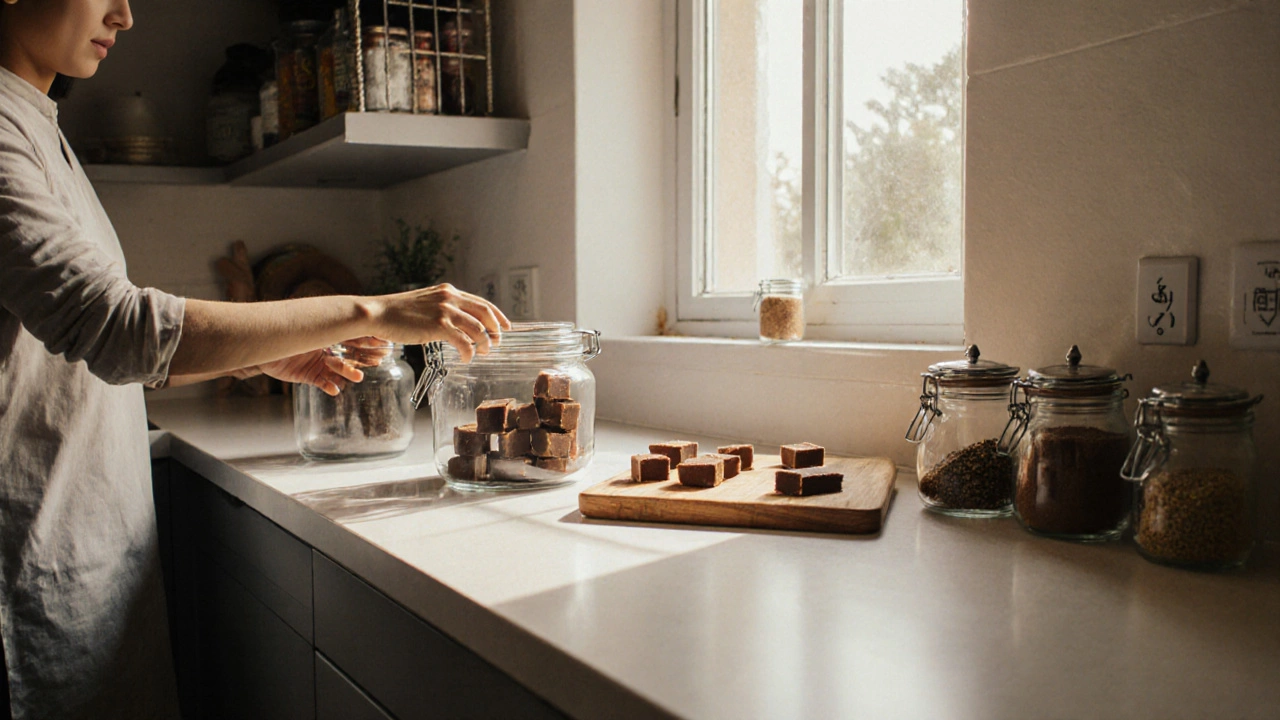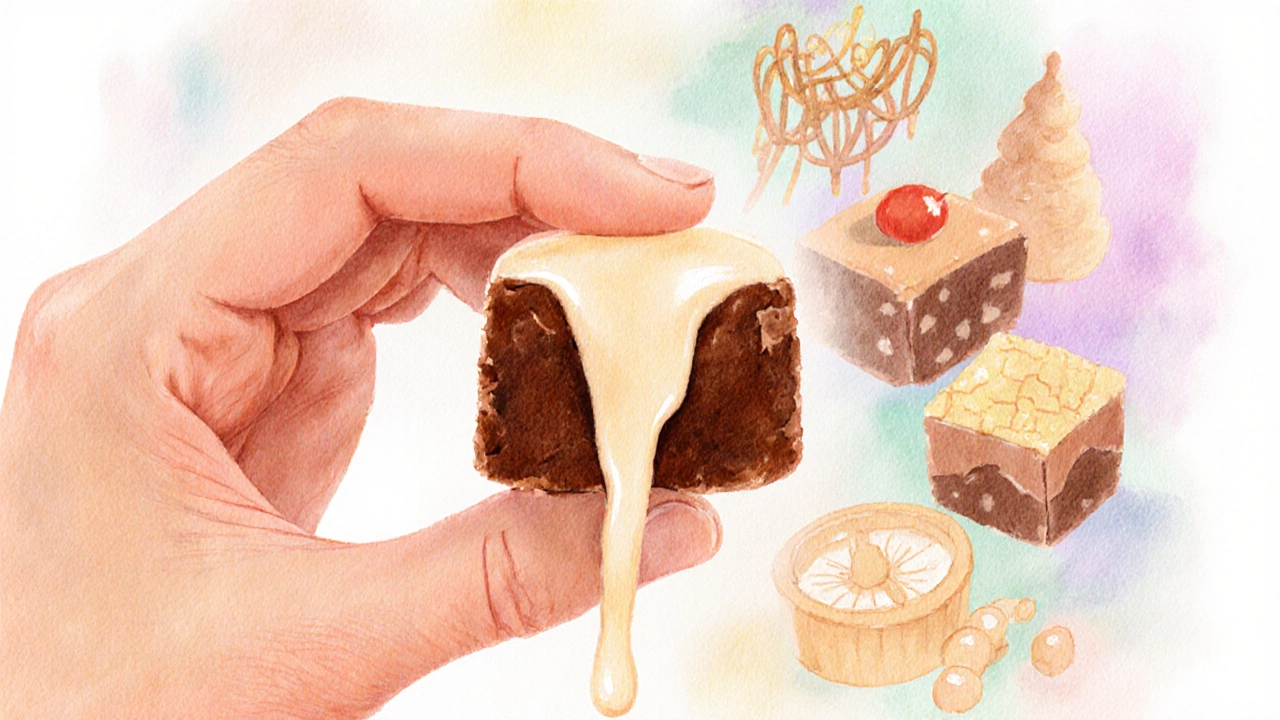Fudge Temperature Calculator
This tool calculates the ideal boiling temperature for soft fudge based on sugar quantity.
Ever pull a piece of fudge from the fridge only to discover it’s snapped like a rock? You’re not alone. The mystery of why some batches stay velvety while others turn into candy bricks has a surprisingly simple answer: it’s all about moisture, temperature, and the way sugar crystals form.
Quick Takeaways
- Control the boil temperature (use a candy thermometer, aim for 240°F/115°C).
- Add a liquid stabilizer like corn syrup, honey, or glucose.
- Stir gently during the cooling phase to limit crystal size.
- Store in an airtight container at 65–70°F (18–21°C) with a slice of bread.
- Re‑soften hardened fudge by microwaving with a splash of milk or cream.
Below we’ll break down the science, walk through the exact steps that keep fudge supple, and troubleshoot the most common hard‑ening culprits.
Understanding the Science Behind Fudge Texture
At its core, fudge is a dense confection made from sugar, butter, and a dairy base such as milk or cream. The final texture depends on three key factors:
- Amount of water remaining after cooking. More water yields a softer, melt‑in‑your‑mouth bite.
- Size of sugar crystals. Tiny crystals create smoothness; large crystals give a gritty, firm texture.
- Fat and stabilizer content. Butter, chocolate, and liquid sugars interrupt crystal growth.
When any of these variables go off‑balance, the fudge can harden.
Key Ingredients and Their Roles
Below is a quick look at the main players and why they matter.
| Ingredient | Primary Function | Typical Ratio (per 2 cups sugar) |
|---|---|---|
| Sugar | Provides sweetness and forms the crystal matrix | 2 cups (granulated) |
| Butter | Supplies fat that coats sugar crystals, limiting their size | 1/2 cup (unsalted) |
| Cream or Milk | Retains moisture; higher fat content → softer result | 3/4 cup |
| Corn Syrup | Inhibits sucrose crystallization, keeping the mixture pliable | 1/4 cup (light) |
| Chocolate | Adds flavor and extra fat; also disrupts crystal formation | 1/2 cup (chips or chopped) |
Notice how each fat‑rich component (butter, cream, chocolate, corn syrup) acts as a crystal blocker. Leaving any out-or using too little-raises the risk of a hard batch.
Step‑by‑Step: The Foolproof Soft Fudge Method
- Combine sugar, butter, cream, and corn syrup in a heavy‑bottom saucepan.
- Heat over medium, stirring until everything melts. Attach a candy thermometer to the side of the pan.
- Bring the mixture to a rolling boil. Once it reaches 240°F (115°C), start timing. This is the "soft‑ball" stage, the sweet spot for soft fudge.
- Remove the pot from heat. Let it sit, uncovered, for 5‑7 minutes. This pause allows the temperature to drop slightly and the crystals to begin forming evenly.
- Stir gently with a wooden spoon until the mixture thickens and loses its glossy sheen. Do not whisk-excessive agitation makes big crystals.
- If you’re adding chocolate, fold it in now, letting the residual heat melt it completely.
- Pour the fudge into a greased 8×8‑inch pan. Smooth the top with a spatula.
- Let it cool at room temperature (65-70°F/18-21°C). Avoid the refrigerator until it’s firm enough to cut, usually 2‑3 hours.
Following this exact temperature window and gentle stirring is the single biggest factor in keeping fudge soft.

Why Temperature Matters: The Role of Temperature
When you boil the sugar‑butter‑cream mixture, you’re evaporating water and concentrating the sugars. Each temperature stage correlates with a specific water content:
- Soft‑ball (236-240°F / 113-115°C): About 7-8% water left - yields a creamy, sliceable fudge.
- Firm‑ball (244-250°F / 118-121°C): Only 4-5% water - creates a firm, almost candy‑like texture.
Going even a few degrees higher can cause the fudge to set hard because there’s not enough moisture to keep the sugar crystals pliable.
Crystallization Control: The Secret of Crystallization
When sugar cools, it wants to line up into crystals. Small, uniform crystals give that melt‑in‑your‑mouth feel; big crystals feel grainy and firm. Here’s how to steer the process:
- Use corn syrup or glucose. These liquid sugars are “invert” sugars that interfere with pure sucrose lattice formation.
- Cool without stirring. Once you remove the pot from heat, a brief pause lets a thin skin form, which seeds tiny crystals.
- Stir once, gently. After the pause, a single slow stir spreads the seed crystals evenly.
- Avoid over‑mixing. Vigorous beating creates many nucleation points, leading to larger crystal clusters.
Think of it like making smooth chocolate: the fewer you agitate, the smoother the final product.
Storage Strategies That Keep Fudge From Turning Into a Brick
Even a perfectly soft batch can harden if you store it wrong. The goal is to maintain a stable humidity around the fudge.
- Airtight container. Seal tightly to prevent moisture loss.
- Slice of fresh bread. Place a small piece of soft bread on top; it releases just enough moisture to keep the fudge supple.
- Room‑temperature pantry. Keep at 65-70°F (18-21°C). Refrigeration speeds up hardening; freezing is okay only if you plan to thaw and re‑soften immediately before serving.
- Separate layers. If stacking multiple layers, put parchment paper between them to avoid a compressed, dense texture.
Follow these tips and your fudge will stay bite‑soft for up to a week.
Troubleshooting: When Fudge Still Gets Hard
Sometimes, despite best efforts, you end up with fudge as hard as a granite countertop. Here’s a quick diagnostic chart:
| Symptom | Likely Cause | Quick Fix |
|---|---|---|
| Very firm, brittle | Boiled past soft‑ball (temp > 245°F) | Re‑heat gently, add 1‑2 tbsp extra cream, stir, cool again |
| Grainy texture | Over‑stirred during cooling | Warm slightly, re‑mix gently, let set |
| Dry, crusty top | Exposed to air for too long | Cover with foil or airtight lid; add a bread slice |
If you’re in a pinch and need to soften an already hard piece, microwaving in 10‑second bursts with a splash of milk works wonders. Stir until you reach the desired consistency, then let it set again.
Creative Variations That Naturally Stay Softer
Adding certain flavors or ingredients can inherently keep fudge from hardening:
- Peanut butter. Its high fat content acts like extra butter.
- Coconut milk. Provides moisture and a subtle sweetness.
- Marshmallow fluff. Introduces aerated sugars that prevent tight crystal formation.
Experiment with these and you’ll discover new textures that stay delightfully soft.

Frequently Asked Questions
Why does my fudge get hard after it cools?
Hardening usually means the mixture was boiled past the soft‑ball stage or too much stirring created large sugar crystals. Keeping the temperature at 240°F and stirring only once after the boil fixes the issue.
Can I use honey instead of corn syrup?
Yes. Honey is another invert sugar that slows crystallization. Use the same volume (¼ cup) and expect a slightly floral note.
Is refrigeration a must for fudge?
Not at all. Refrigeration dries out fudge and makes it hard. Store at room temperature in an airtight container; reserve the fridge only for longer‑term storage (over a week).
My fudge turned out grainy-what went wrong?
Grainy texture means the sugar crystals grew too large, often from over‑mixing or cooling too quickly. Next time, let the mixture sit undisturbed for a few minutes before the single gentle stir.
How long can soft fudge stay fresh?
When stored in an airtight container with a slice of bread at 65-70°F, fudge stays soft for 5‑7 days. After that, it may start to dry out, but you can still re‑soften it by warming with a splash of milk.
Now you’ve got the science, the step‑by‑step method, storage hacks, and fixes for every common hiccup. With these tools, the only thing you’ll have to worry about is how many people will beg for a second piece.